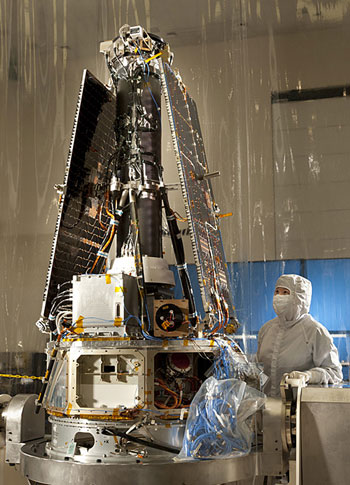| Jun 18, 2013 |
NASA's newest solar mission spacecraft ready for launch
|
|
(Nanowerk News) The Interface Region Imaging Spectrograph (IRIS) spacecraft is on track for a launch from Vandenberg Air Force Base in California on June 26. IRIS will fill a crucial gap in the ability of scientists to advance Sun-Earth connection studies by tracing the flow of energy and plasma through a dynamic interface region – the chromosphere and transition region – between the solar surface and the solar corona.
|
|
"The entire IRIS team is enormously pleased that we've reached this crucial milestone," said Gary Kushner, Lockheed Martin (NYSE: LMT) IRIS program manager. "After many months of hard work by the Lockheed Martin team and all of our collaborators and subcontractors in designing, engineering, building and testing the instrument and integrated spacecraft, our goal of putting IRIS into orbit is in sight and we look forward to producing great science at a low cost."
|
 |
| NASA’s Newest Solar Mission Spacecraft Ready for Launch
|
|
The goal of the IRIS program is to better understand how energy and plasma move from a lower layer of the sun's surface called the photosphere, through the chromosphere layer and to the outer corona layer. Observation into this movement has been a fundamental challenge in Solar and Heliospheric science, and the IRIS mission will open a window of discovery into this crucial region by providing observations necessary to pinpoint physical forces at work in this little understood piece of real estate near the surface of the sun.
|
|
"The interpretation of the IRIS spectra is a major effort coordinated by the IRIS Science Team that will utilize the full extent of the power of the most advanced computational resources in the world. It is this new capability, along with development of state of the art codes and numerical models by the University of Oslo, that capture the complexities of this region, which make the IRIS mission possible. Without these important elements we would be unable to fully interpret the IRIS spectra," said Dr. Alan Title, IRIS principal investigator and physicist at the ATC Solar and Astrophysics Laboratory in Palo Alto. "With IRIS, we have a unique opportunity to provide significant missing pieces in our understanding of energy transport on the sun. The complex processes and enormous contrasts of density, temperature and magnetic field within this interface region require instrument and modeling capabilities that are now finally within our reach."
|
|
The IRIS observatory will fly in a sun-synchronous polar orbit for continuous solar observations on a two-year mission. It will obtain ultraviolet spectra and high-resolution images focused on the chromosphere and the transition region to the outer corona. Spectra will cover temperatures from 4,500 K to 107 K, with images covering temperatures from 4,500 to 65,000 K.
|
|
NASA's Ames Research Center at Moffett Field, Calif. is responsible for mission operations and the ground data system. The Norwegian Space Centre and NASA's Near Earth Network will provide the ground stations to support the IRIS mission using antennas at Svalbard, Norway, Fairbanks, Alaska, McMurdo, Antarctica and Wallops Island, Va. The science data will be managed by the Joint Science Operations Center of the Solar Dynamics Observatory, run by Stanford and Lockheed Martin. NASA's Goddard Space Flight Center in Greenbelt, Md., manages the Explorers Program. NASA's Launch Services Program at Kennedy Space Center, Fla., is responsible for launch management.
|
|
Part of NASA's Small Explorers, which deliver space exploration missions costing less than $120 million, IRIS was designed and built at Lockheed Martin Space Systems Company Advanced Technology Center (ATC) in Palo Alto, Calif. The program was developed with support from Lockheed Martin's Civil Space line of business as well as partners Smithsonian Astrophysical Observatory, Montana State University, Stanford University and the University of Oslo.
|
|
Over the years, NASA's Explorers Program has launched a number of Explorer spacecraft carrying a wide variety of scientific investigations. It provides access to space using one of several, lower-cost expendable launch vehicles available through NASA's launch services program.
|

